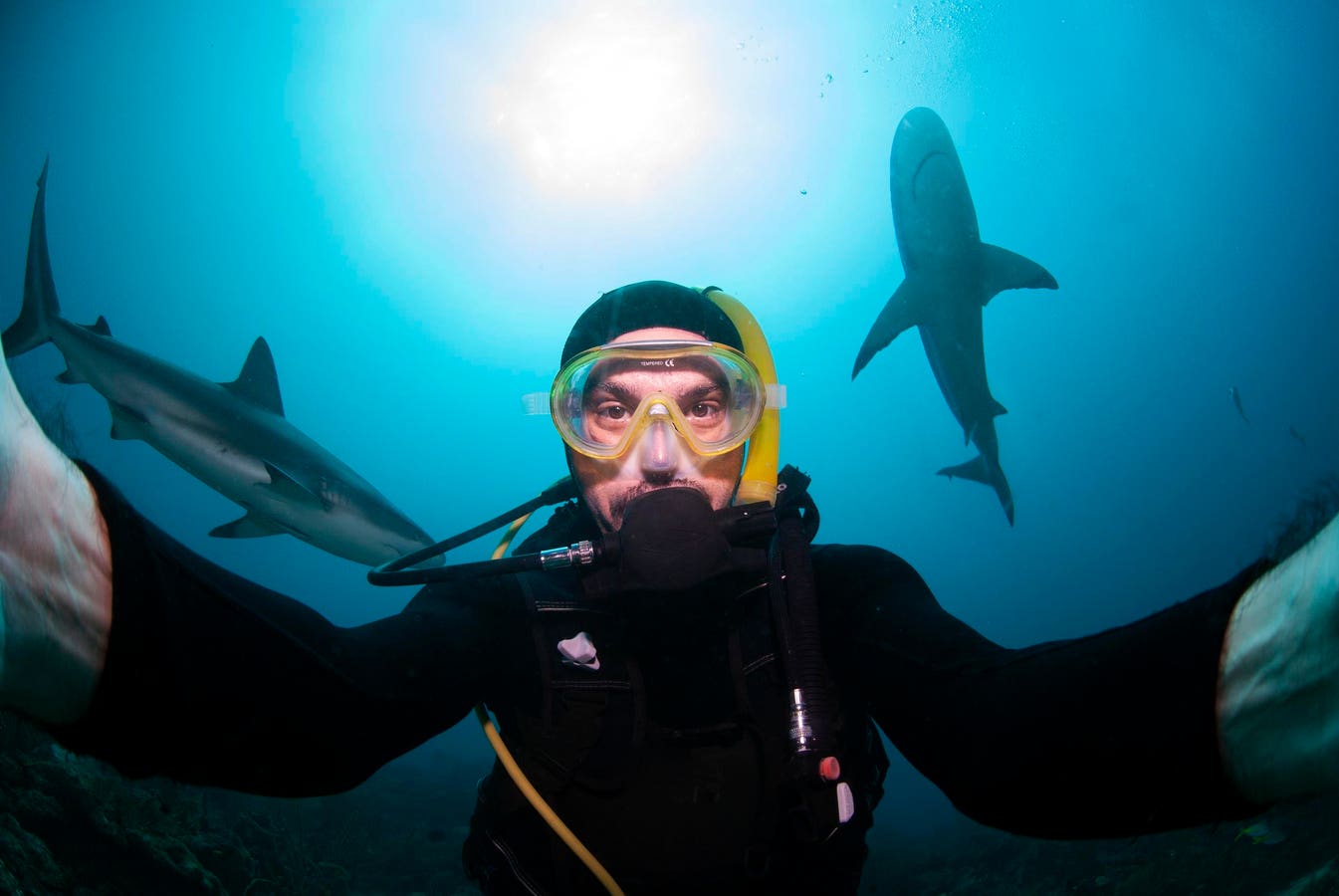Sharks are wild creatures that are part of a delicate and vital ecosystem. Approaching them … More
Social media has a way of warping reality.
Filters, carefully chosen photos, and highlight reels can make ordinary lives look extraordinary. We know this to be true of everyday life, with influencers touting what looks to be a “perfect” life. But the pressure to perform online is not just affecting self-esteem of, well, everyone. It’s becoming physically dangerous. The most extreme version of this is the rise of “death by selfie,” a grim phenomenon where people die trying to get the perfect photo in risky places. One study found that 379 people globally died due to selfies between 2008 and 2021, with even more injured. Now, this trend is reaching our ocean, where sharks are the latest unwilling participants in this social media spotlight.
While sharks sometimes bite due to competition, territorial defense, or while hunting, a new study published in Frontiers in Conservation Science suggests they may also lash out as an instinctive response to feeling threatened rather than intentionally targeting humans. (See a more in-depth analysis about those points here.) And, according to the researchers, their work also points to a growing number of shark-related incidents being tied directly to people trying to get too close, often with a phone or camera in hand. Whether they are attempting to pet a passing shark, pose for a selfie, or even grab its dorsal fin, they are all treating the animal not like a predator that has been around for millions of years… but a prop. And the result? A surge in injuries, and in some rare but tragic cases, death.
Professor Dr. Eric Emile Germain Clua of the Paris Science et Lettres (PSL) Research University, and the lead author of the study, doesn’t mince his words about the troubling trend: “I don’t encourage, as many influencers do on social networks, [people]
to cling to a shark’s dorsal fin or stroke it, under the pretext of proving that they are harmless.” Clua told The Times of London says this is not just a personal safety issue, but a conservation concern, too. Spooking a shark or invading its space can disrupt natural behaviors, and when people are hurt, sharks often pay the price in bad press or even retaliatory culls.
Recently, the real-world consequences of this behavior came into sharp focus. A Canadian tourist on vacation in the Caribbean was allegedly trying to snap a photo of a shark when the seven-foot (2.1 meter) bull shark retaliated, biting off both her hands. “While on what was supposed to be a relaxing vacation, my sister-in-law and her husband, my brother, lived what can only be described as a nightmare,” the family said about the horrific accident. Barak Tzach, 40, a father of four was also killed while trying to film sharks in the water off Hadera, Israel. While cases like this tragic, and very rare, they highlight the potential danger of treating wildlife like a petting zoo animal. A shark is not the same as a domesticated goat, and should not be treated as such. (Plus, the goats usually bite anyways!)
A shark that tolerates a diver’s presence one moment may interpret a sudden movement, flash of … More
The study singles out so-called “shark influencers” as a source of this growing problem. These are people, often experienced divers or conservationists, share videos of their close encounters with sharks. More often than not, viewers see these people stroking them, hitching rides on their fins, or free diving within inches of their faces. Their goal? Supposedly to raise awareness or promote shark conservation by showing these animals in a calmer, less aggressive light. But the problem is that social media strips away context. Followers don’t always see the training, the precautions, or the years of experience behind the scenes. What they do see is someone getting up close and personal with a shark and making it look cool, safe, and easy. Unfortunately, when untrained people try to copy these stunts, the outcome can be very different.
Not to mention that these are wild animals! No matter how peaceful a shark might appear in a video, it is still a(n apex) predator with its own instincts, thresholds, and triggers. Unlike animals in captivity that may be somewhat habituated to human presence, wild sharks are unpredictable by nature. They operate in an environment we barely understand, responding to signals we can’t always detect (e.g. like shifts in water pressure, smells carried on currents, or even electrical impulses). When someone gets too close, especially without the knowledge of how to read a shark’s body language or behavior, it’s not just risky… it’s reckless. A stressed shark, startled by sudden movement or unfamiliar touch, can respond the way any wild animal might: with a defensive bite. And because many of these encounters happen in popular tourist areas with little regulation or enforcement, there is often no one to step in before something goes wrong.
That’s why Clua and his colleagues are calling for a shift in not just behavior, but in our overall mindset towards nature and wildlife. “Just look at it,” he says of encountering sharks in the wild. “Enjoy its beauty, but remember they are wild animals, predators that can act as predators. It is not only a matter of safety but also of respect.”
Wild animals are not props. They don’t perform on cue, and they’re not there for our entertainment or social media clout. A shark that tolerates a diver’s presence one moment may interpret a sudden movement, flash of light, or accidental touch as a threat the next. And while a seasoned shark diver might know how to deescalate that moment, a tourist with a GoPro likely doesn’t. By ignoring or downplaying that reality, influencers can unintentionally promote a false sense of security that endangers their followers and disrespects the animals they claim to protect.
None of this is to say that shark conservation isn’t important, or that the people posting these videos don’t care about the animals. In fact, many of them have dedicated their lives to protecting sharks, raising awareness about the threats they face from overfishing, habitat loss, and climate change. But the messaging gets muddled when the footage looks more like a daredevil stunt than an educational tool. The line between admiration and exploitation is a thin one, especially in an age where virality can be just one dramatic video away. But when it comes to sharks, pushing that line puts both humans and animals at risk. Respect for wildlife means keeping a safe distance, resisting the urge to touch or “pet” these animals, and remembering that not everything needs to be captured for likes.
Maybe this study is a reminder we all need to hear — nature isn’t a backdrop for content creation. It’s a living, breathing system with its own rules. We should follow them.








